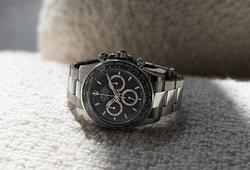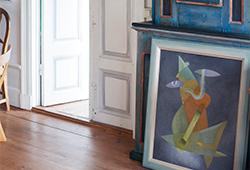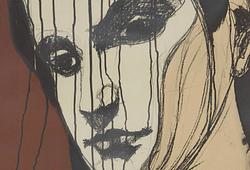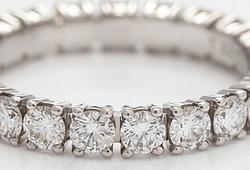Laila Pullinen
LAILA PULLINEN, "MUTE ORACLE".
Polished bronze and black Hyvinkää granite 163x70x67 cm.
Exhibitions
Galleria Agora 1963. Venice Biennale 1964.
Literature
Atti D'amore (Wäinö Aaltonen museum publications series no. 49, 2006), p. 122.
More information
Mute Oracle (1963, polished bronze and black Hyvinkää granite)
Mute Oracle is unquestionably one of the main works of leading Finnish sculptor, professor Laila Pullinen (1933-2015). It is the first example of the artist working at a life-size scale of nearly two metres by combining stone and bronze, and of a theme to which she returned with vigour later in her career from the 1990s onwards.
The stone portion of the work was carved at the Forsman stoneworks and the bronze part was evidently cast at Arturo Bruni’s foundry in Rome. Pullinen mainly lived and worked in Rome, maintaining a studio on the ground floor of the Villa Lante. The work was first unveiled at the Galleria Agora, Helsinki in October 1963, propelling Pullinen to the forefront of her generation by finally capturing first prize in the State Art Competition. This accomplishment came after attempts spanning several years, including second prize in 1962, third prize in 1957 and fourth prize in 1956. Pullinen was also chosen to represent Finland at the Venice Biennale in 1964 as the only sculptor accompanying graphic artists Ina Colliander, Simo Hannula and Pentti Kaskipuro.
In terms of its technical approach, Mute Oracle is related to some smaller sculpted works from the same period that were also entered in the Biennale [Pelléas and Mélisande (1962), Black Angel (1963), Gioia Nera (1966), Honeybunny (1965), Marilyn Monroe in memoriam (1966)], but its distinguishing feature is the sheer size of the work and the manner in which the form of the upright stone expresses the dimensions and proportions of a human figure.
The “silent character” is a loquacious feature of the work that may be considered to allude to the response of the priests to Emperor Julian the Apostate of Rome (reigned from 361 to 363 CE) when he tried to revive the thousand year-old Pythian heritage in the 360s:
“Tell the emperor that my hall has fallen to the ground. Phoebus no longer has his house, nor his mantic bay nor his prophetic spring: the water has dried up.”
The question thus concerns a form of heritage fallen quiet, and a silence of stone. The work feels inherently fragmentary, as is the case with many of Pullinen’s sculptures from this period (including the Mata Hari suite). Figures containing figurative elements comparable to sculptural fragments from antiquity generally play a key role in Pullinen’s idiom. Using the stylistic devices of modernism, the polished bronze encircles and follows – or opposes – these forms like a flag in a gentle breeze. For Pullinen the more rigid and quieter stone expressed the corpus, while the more liberated and intangible bronze was always the anima.
Curator Heli Harni offers the following report in her biographical essay the Sculptor’s Professorship, published as part of the Pullinen retrospective Atti D'amore (Wäinö Aaltonen museum publications series no. 49, 2006):
“The critic Erik Kruskopf considered the name of the Mute Oracle sculpture mysterious, with its features combining in silence as it wraps itself up in a mantle of introversion. He nevertheless stressed that the sculpture could be viewed in many other ways. He also perceived in it two figures, with one protecting the other. As a single figure it seemed to hide in its shell and turn in on itself […] The sculpture Electra’s Joy (1964), in which undulating bronze cloaks a tall granite figure, was purchased from the Biennale for the Gonnet collection in Turin. Erik Kruskopf said that it resembled a classical female torso standing in contrapposto with the bronze floating in the breeze like a garment.”
The theme noted by Kruskopf invariably recurs in all of Pullinen’s combination sculptures in stone and bronze (such as the 1994 work Cohesion that stands in front of the Finnish Postal Service logistics centre in Oulu). Works in which the bronze seems to drape over an upright figure like a garment give a particular impression of parting some kind of curtain and moving some obstacle aside so that the truth is revealed from beneath in all of its intensity.
Through their superficial forms and choices of name (e.g. gioia nera: black joy) a certain quasi-erotic nuance runs through these works: the materials employed – black granite and marble, and particularly ebony – inherently seem to signal some older and perhaps Hellenistic pagan roots that essentially provide a perfect counterpoint to the emotional brightness of the bronze.
The fact that the oracle is silent or speechless does not stop it communicating. Pullinen even seems to amplify the point in her works that aesthetic communication already essentially lies beyond the limits of language in a realm of form and reflection, in allegory and implication – in the enduring message of beauty that reaches the present moment after travelling for millennia – if only one is able to fall silent and accept its message.
- Jean Ramsay, 2016






























